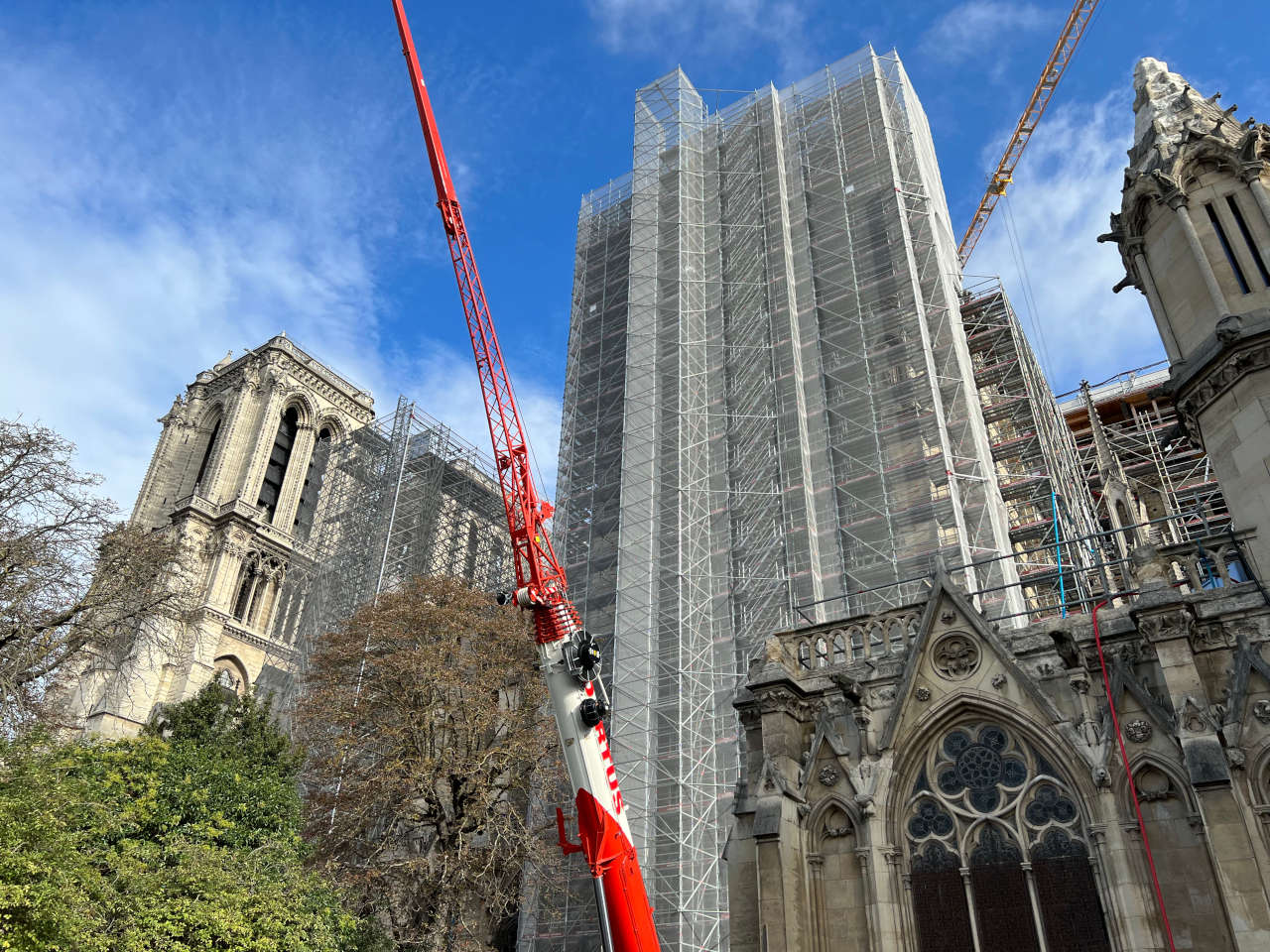June & July 2022
Preparatory Excavations
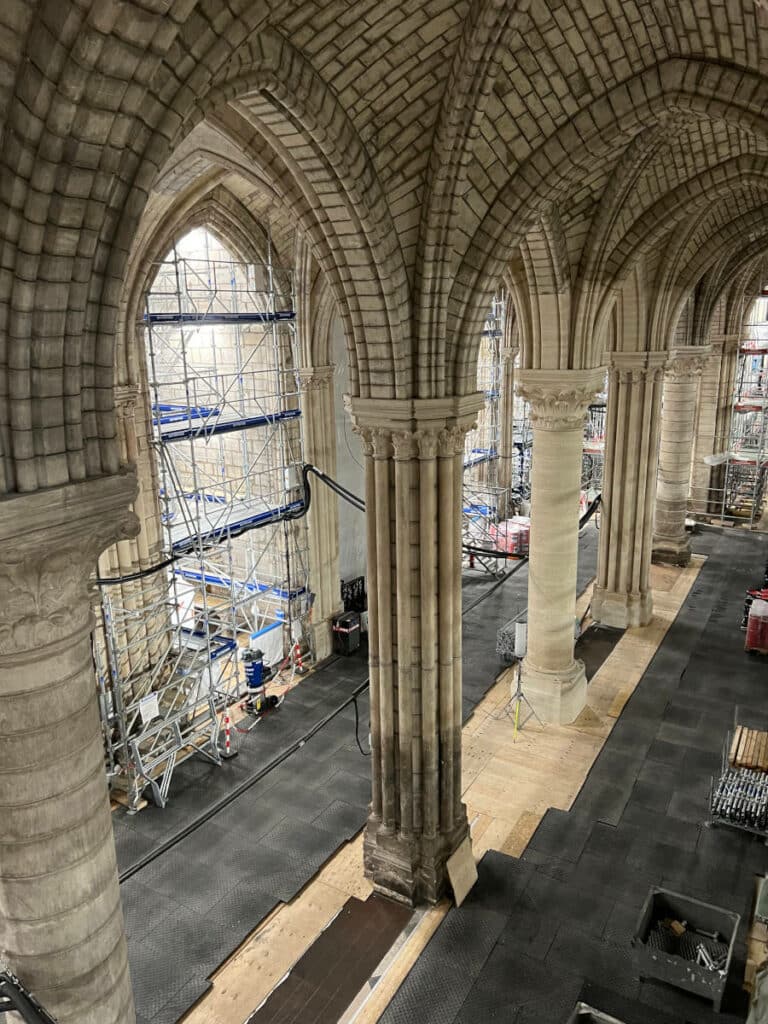
The excavations at the transept crossing are now complete, and the ground is prepared to support the 600 ton, 100 meters high scaffolding that will help reconstruct the spire.
The excavations were made possible by the removal of the podium located at the transept crossing, which was badly damaged during the fire. Because of this exceptional opportunity, the excavation period was able to extend for more than two months. The discoveries that present the greatest artistic and heritage interest are pieces of sculpture that belong to the old rood screen of the cathedral (13th century), as well as two anthropomorphic, lead sarcophagi.
The first sarcophagus discovered is in a relatively good state of preservation, and researchers estimated that it dates from approximately the 14th century, although the identity of the deceased is still unknown.
The second sarcophagus contained inscriptions that made it possible to identify the interned as Canon Antoine de La Porte (1627-1710), who financed a large part of the choir’s redevelopment at the behest of King Louis XIII. It dates from the beginning of the 18th century, but was found in a lesser state of preservation.
The sarcophagi were removed from the cathedral for further study. Once the research is complete, they will be placed back in the vaults of Notre-Dame.
May 2022
General Updates

The operations required prior to the restoration work are complete and the first stages of interior restoration have launched. Most of this phase’s operations takes place inside the cathedral, such as cleaning and restoring the mural paintings, marble floors, ironwork and so on. Other works, like the restoration of the stained-glass windows, take place in offsite workshops.
The restoration of the Grand Organ is progressing well, both in expert workshops and inside the cathedral, where the most important cases and pipes have remained.
Restoration of the Stained-Glass Windows
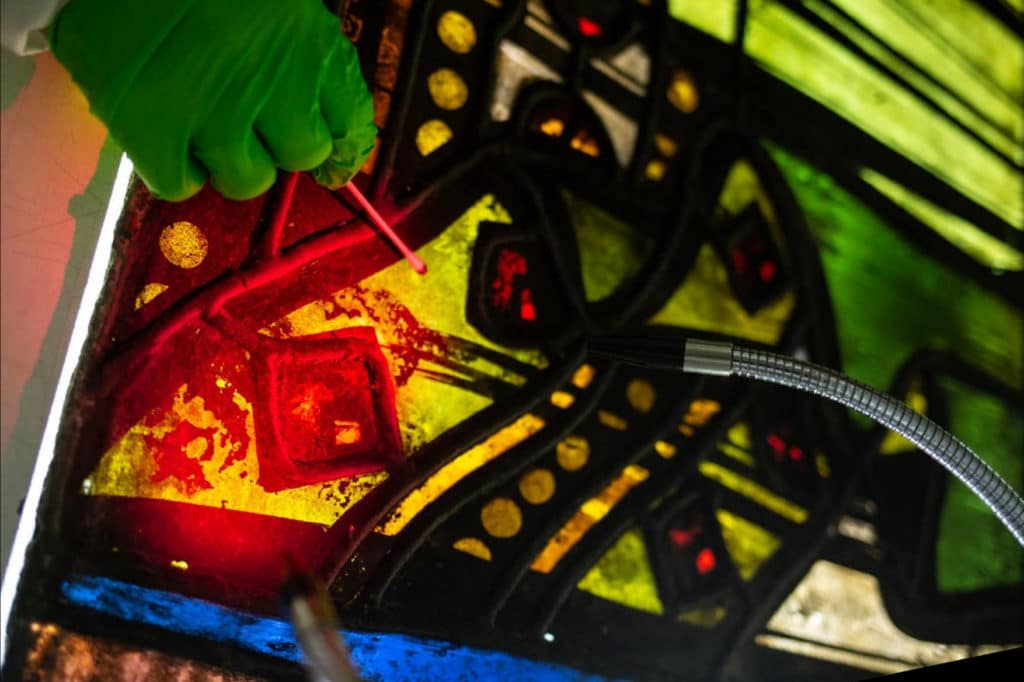
Thankfully, none of Notre-Dame Cathedral’s stained-glass windows were destroyed or damaged by the April 15, 2019, fire. However, many of them were exposed to smoke and already dusty, so they must be thoroughly cleaned to remove the dirt.
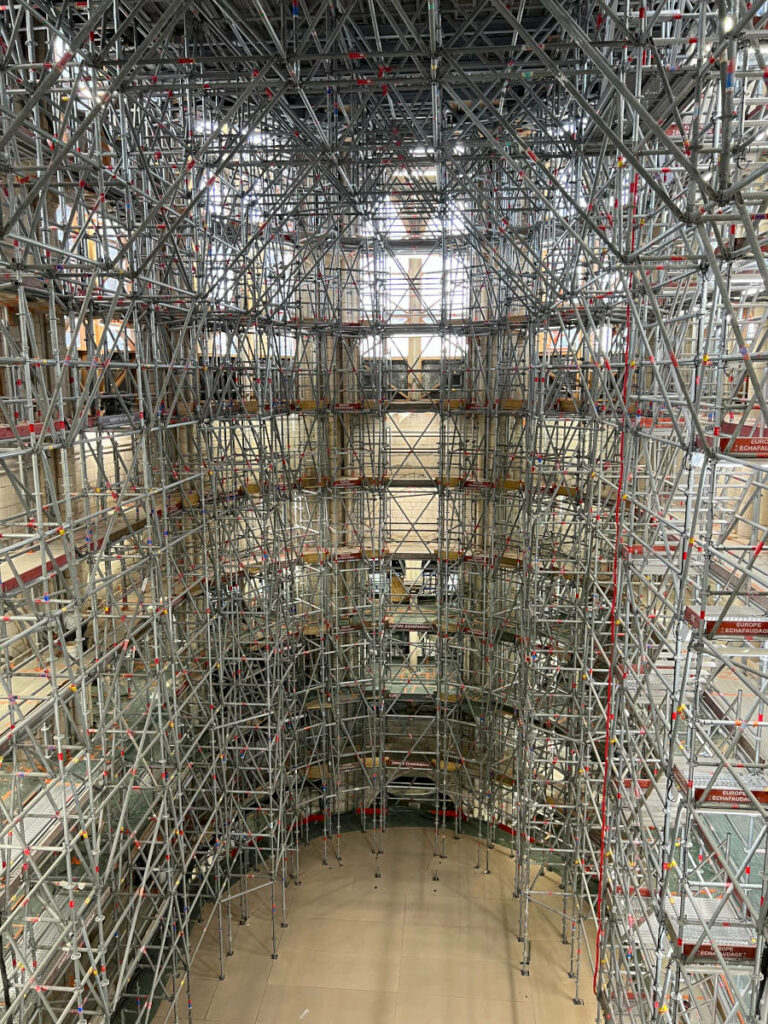
The stained-glass windows of the 39 high bays of the nave, choir and the transept, as well as the stained-glass windows of the sacristy, were removed as a protective measure to not interfere with the construction site. These windows will be cleaned and restored in workshops before returning to the cathedral. The windows of the chapels and the stands will be cleaned on site. The stained-glass windows were distributed amongst workshops where their restoration recently began, so they will be ready for the reopening of the cathedral in 2024.
Restoration of Notre-Dame’s Paintings on Canvas
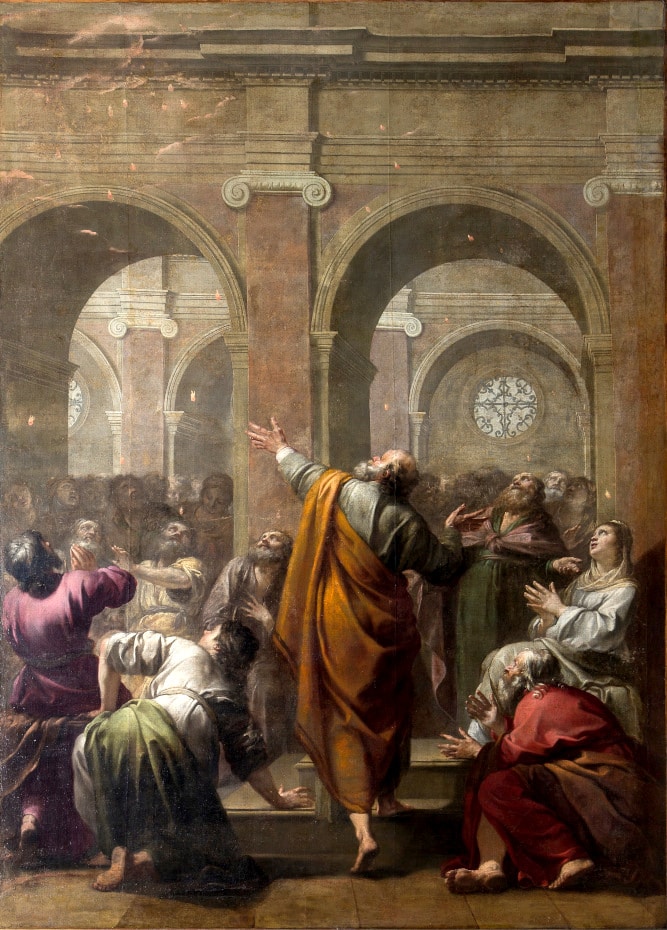
The restoration of the cathedral’s paintings began in October 2021 and is proceeding according to schedule. The 22 paintings were divided into four groups and entrusted to three cohorts of restorers. In the condition reports on the first paintings, the restorers observed that the old relining of each painting was in perfect condition. As a result, they only need to be preserved and do not require any further intervention. Conversely, the canvases themselves do need to be restored. Restoration work began on 14 of the canvases with the first step of cleaning the paintings.
Four Great Mays of Notre-Dame have already been completely cleaned:
- The Martyrdom of Saint Stephen by Charles Le Brun
- The Martyrdom of Saint Andrew on the Cross by Charles Le Brun
- Saint Andrew quivering with joy at the sight of his torture by Gabriel Blanchard
- The Preachings of the Prophet Agabus to Saint Paul by Louis Chéron
Five paintings are currently being cleaned:
- The Descent of the Holy Spirit, a May by Jacques Blanchard
- Saint Charles Borromeo Giving Communion to the Plague Victims by Carl Van Loo
- The Visitation by Etienne Jeaurat
- The Preaching of Saint Peter in Jerusalem, a May by Charles Poërson
- The Nativity of the Virgin by Louis and Matthieu Le Nain
Tests are being carried out on the following five paintings to determine the appropriate protocols to proceed with the cleaning:
- The Nativity by Hieronymus Francken
- Saint Paul blinding the false prophet Bargesu, a May by Nicolas Loir
- Saint Bernardin of Siena Delivering the City of Carpi by Ludovico Carracci
- The Martyrdom of Saint Catherine by Joseph-Marie Vien
- The Virgin of Mercy by Lubin Baugin
After cleaning the canvases, the canvas and pictorial restoration works can begin. Along with the paintings, the frames of these canvases are also currently being cleaned.
April 2022
General Updates
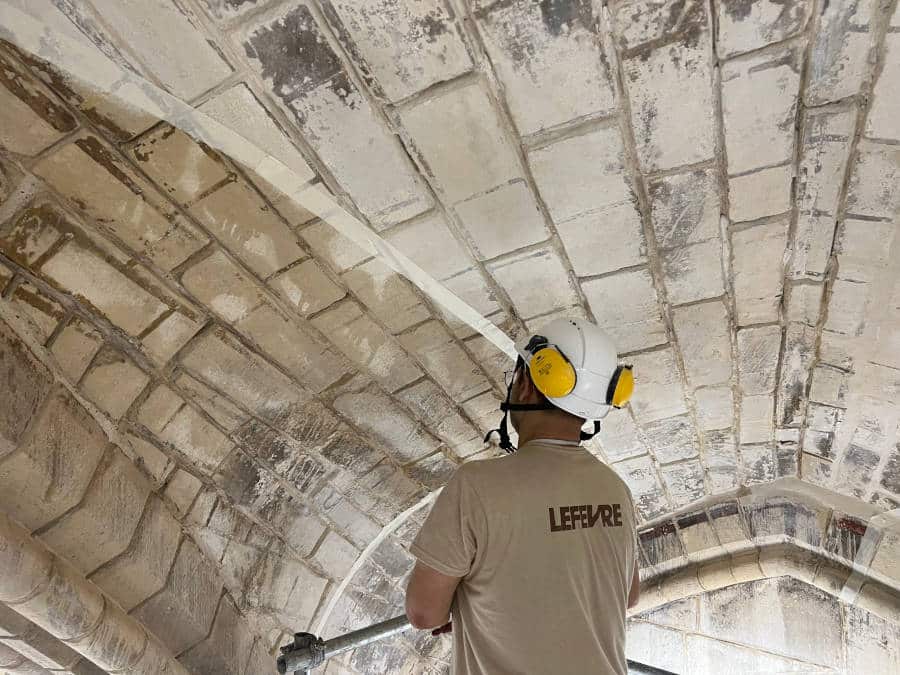
Significant progress was made towards completing the preparatory work for the cathedral’s restoration, including vacuum cleaning the interior of the cathedral, desalinating the lower arches of the vaults and repairing the technical systems damaged by the fire.
To date, the nave and the transepts have been entirely treated. Cleaning the ambulatory is in progress, before teams move on to the floors of the chapels of the choir and the sacristy attic.
Thirty workers are tasked with updating the electrical, water and heating infrastructure inside and outside the cathedral, in line with contemporary needs and safety guidelines. These updates are due for completion in summer 2022.
Contracts Awarded for Interior Restoration Works
Contracts were awarded for the reconstruction of the Viollet-le-Duc spire, the vaults and the roof of the transept. The selected companies are now able to begin their work.
The contracts relating to the interior restoration works of the cathedral, divided into 37 lots, were notified in the spring. This includes restoration of the masonry, ironwork, paintings, stone sculptures, stained-glass and furniture, restoring all their brilliance to the interior decoration of the cathedral.
The contracts relating to the restoration of the Viollet-le-Duc spire and the transepts, divided into 9 lots, were awarded during the months of April and May, including the scaffolding, building the spire’s framework, rebuilding collapsed vaults, restoring the credenza walls, and so on.
Reconstruction of the Vaults
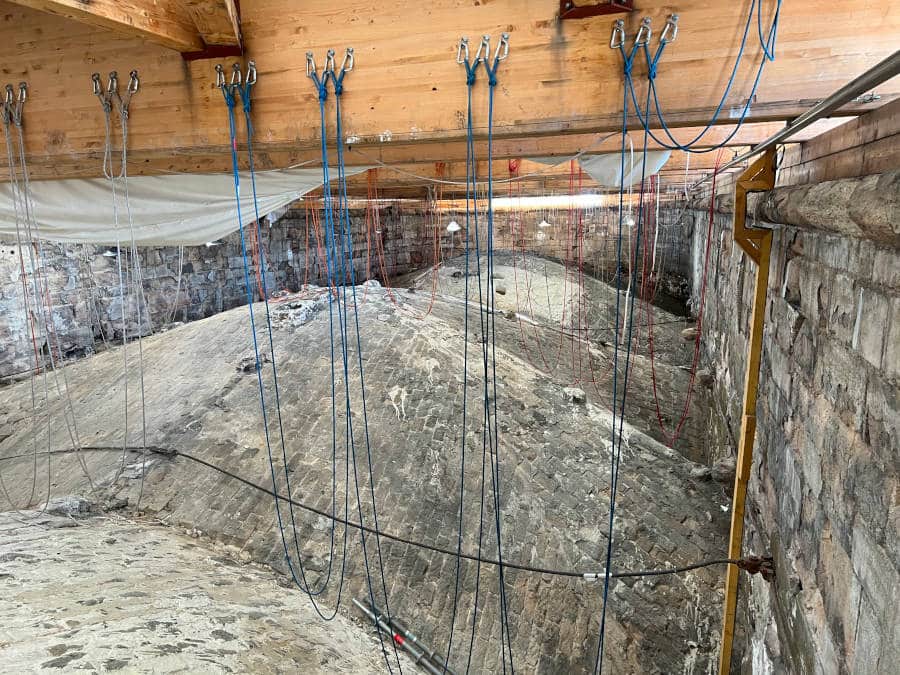
The 2019 fire led to the collapse of about 15% of the cathedral’s vaults. To restore them, two types of stones are needed: hard stones, particularly to reconstruct the collapsed arches and replace the stones in the walls, and softer stones, also used in reconstructing the collapsed or damaged vaults. This operation requires new stones that are compatible with Notre-Dame Cathedral in terms of appearance and their physical and chemical characteristics.
Stage 1: Quarrying the stones in the Oise
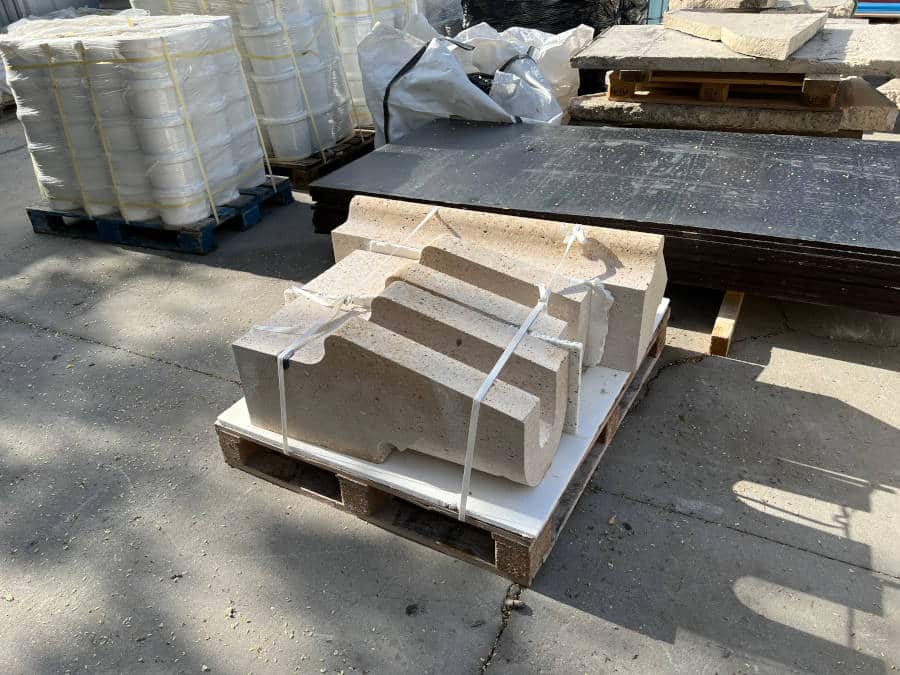
The first stage of reconstruction is quarrying the stones. A research program involving geologists and sedimentologists has identified several quarries in the Lutetian geological basin, the source historically used to supply stone for the cathedral. For the extraction of hard stones, the quarry of Croix-Huyart was chosen in the Oise, north of Paris. Eight other quarries, located in the areas of Saint-Maximin (Oise) and Soissons (Aisne), have been selected for the extraction of soft stones.
The first stage of reconstructing the collapsed vaults was launched in March 2022 in the stone quarry of Croix-Huyart, with the extraction and preparation of the 600m3 of hard stone blocks.
Restoration of the Stained-Glass Windows
Since the end of April, four workshops of stained-glass artists have taken turns removing the 12 high bay windows of the transepts, which will be restored along with the stained-glass windows that were already evacuated from the cathedral. These 12 bay windows were not removed the day after the fire because they did not impede the operations to secure the cathedral’s structure. Along with this operation, the stained-glass windows already removed in 2019 have been transported to the workshops selected to restore them.
January 2022
Works Performed Since End of Safety Phase (second half of 2021)
The large marquees installed on the cathedral’s square that sheltered the fallen and removed parts of the cathedral (stones, statues, charred timbers, etc.) have been dismantled, which will allow the Pont au Double to reopen, giving access to the Left Bank of the Seine River in the fall of 2022.
A temporary sliding roof now extends over the whole building, including the crossing of the transept, which ensures full waterproofing.
The vaults have been fully secured by large supports in the choir, nave and transept.
Four anchoring points have been installed at the crossing of the transept, which will be used to raise and support the new spire.
2022 Works Plan
Before the restoration of the interior can begin in earnest, preparatory works must first be completed. This includes:
- Ongoing full cleaning of the cathedral (floors, walls, vaults, windows, ceilings), vacuuming up the lead dust on the stone and stained-glass windows.
- Ongoing desalination of the inner curves of the vaults. In 2021, architects noted salt efflorescence on certain stones that can make them fragile and eventually lead to crumbling. This is linked to the excess humidity present in the cathedral following the fire. A desalination effort began in December 2021 to stop this process. After measuring the salt levels present in the stone, experts brush the inner curves (intrados) of the vaults, remove the joints between the stones and apply a mortar-based coating, covering the parts of the affected vaults. These steps are repeated until the salt levels decrease and the stone is considered healthy. This operation is due to conclude in April.
- Removal of all technical cables, severely damaged during the fire. This involves removing all electrical cables, water circulation pipes and heating from the cathedral, located both inside and outside the building. The technical installations will be completely redesigned and renewed as part of the restoration project, in a coherent manner that respects the building.
Restoration of the Grand Organ
The Grand Organ was dismantled and removed in December 2020. Three specialized organ workshops were selected in the fall of 2021 to carry out the restoration, and the Grand Organ is undergoing lead dust removal and ongoing restoration until six months before the cathedral’s reopening, when the instrument will be reharmonized in the cathedral.
Restoration of the Cathedral’s Interior
The cathedral will be restored to its original state, as it was before the fire. To engage the experts tasked with restoring the Notre-Dame’s interior, the Établissement Publique analyzed offers and contracts before the end of February 2022. Restoration works are planned from March 2022 through 2023 and include the restoration of the higher bays of the cathedral and the stained-glass windows.
Spire and Transept
The spire and transept will be rebuilt according to their state after Viollet-le-Duc’s restoration in the 1860s. Contract tenders were submitted at the end of January 2022, with contract awards decided by the end of April. The works include detailed studies, building the scaffolding, timber framework of the spire and covering. These works began in May 2022.
Nave and Choir
The call for tenders for works in the nave, choir, timber framework and covering were announced in March 2022, with works due to start in October 2022.
Technical Works and Restoration of the Interior
The call for tenders related to the technical works of the cathedral’s interior is scheduled for the last quarter of 2022.
Belfries and Bells
The north belfry was partially burned in the 2019 fire, and the bells are to be removed in preparation for restoration.
Financial Update
Friends of Notre-Dame de Paris has raised $34 million since its inception and aims to raise $3 million in 2022.
For every dollar raised since 2017, more than 90 cents go directly to our programs to restore Notre-Dame Cathedral.
